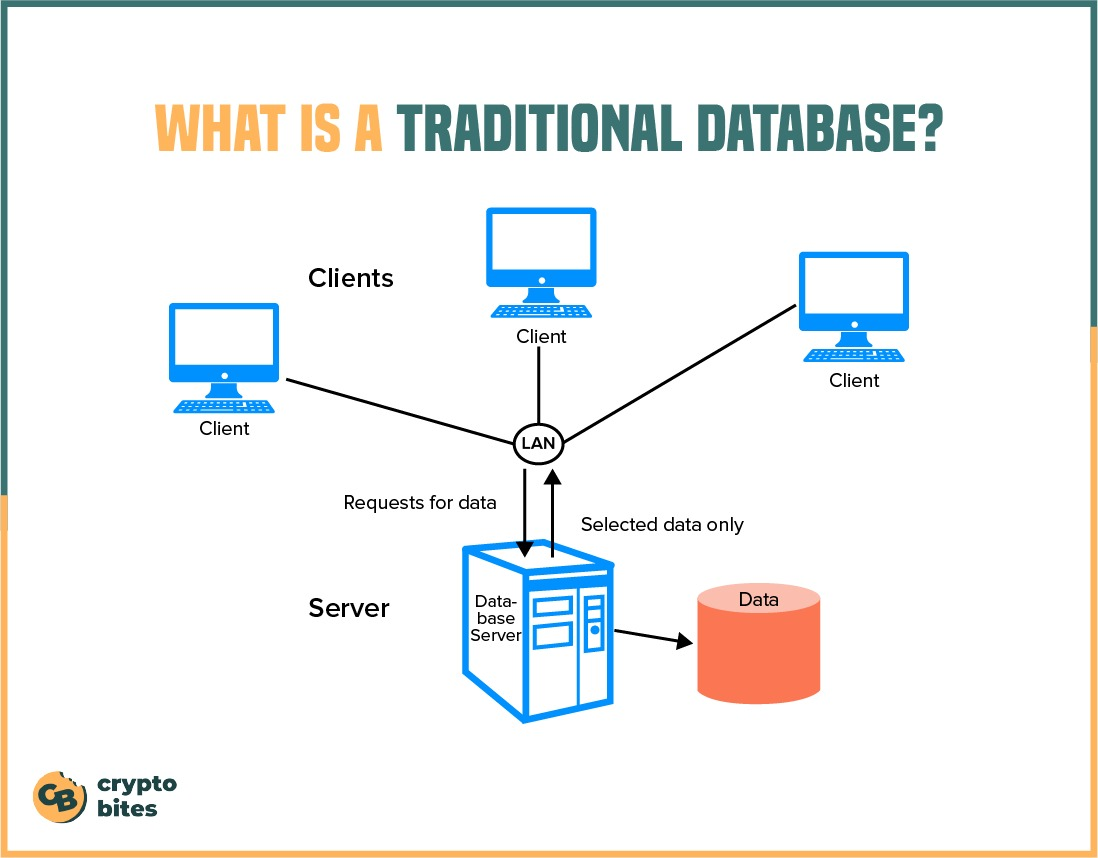
What Sets Blockchain Solutions Apart From Conventional Record Keeping Solutions
Disclaimer: This is not intended as investment advice in any form.
Cryptocurrency and blockchain solutions are making waves across various industries today. Originally designed for financial record-keeping, blockchain has expanded its reach.
Ever wondered what makes blockchain stand out in the world of data management? And exactly what sets blockchain solutions apart from conventional record keeping solutions?
Blockchain, born in 1991, serves as a secure digital data storage system. It functions on a distributed ledger, tracking changes to assets within the chain.
According to Statista, worldwide investment in blockchain solutions will soar from $3.7 billion in 2020 to $15.85 billion in 2024.
Blockchain technology is leading the way in data-driven recordkeeping.
This article explores what sets blockchain solutions apart from traditional record-keeping systems.
What is a Traditional Database?
A traditional database is a type of data structure that helps store and handle data.
Traditional database can be compared to a library where the librarian (the authority) holds the keys to all the books (the data).
When you (the client) want to borrow a book, the librarian checks your library card (verifies your identity) before letting you access the books.
All the books are kept in one place (centralized server), and the librarian has the power to change information about the books or even remove them if necessary.
Just like in a library, if the security is not tight enough, someone could potentially change the book records or take them away. This setup works well for many situations, but the security is super important here.
Usually, SQL is used to query the data.
Here is an illustration that demonstrates how a traditional database works:

Traditional databases follow a client-server setup. Clients, which are the end-users, ask the server for specific data. The server handles these requests.
For security reasons, the client software has to be verified before it can be used. Only those with login credentials and passwords can access private databases.
What is a Blockchain Database?
A blockchain database is a decentralized collection of data, recorded and stored across a network of computers, known as nodes. Each piece of data, or ‘block’, is linked to the previous one, forming a ‘chain’.
The data can represent anything from currency transactions, as in the case of cryptocurrencies, to contracts, records, or other valuable information.
Since the transactions are recorded across many computers any involved record cannot be altered independently, without the alteration of all subsequent blocks. This makes blockchain database extremely secure.
The key features of a blockchain database include:
- Decentralization: Unlike traditional databases that store data in one location, blockchain spreads the data across many nodes, making it less vulnerable to cyber attacks or data loss.
- Transparency: While personal identity may be hidden, the transactions themselves are visible to anyone within the network, ensuring transparency.
- Immutability: Once data is entered into the blockchain, it is extremely difficult to change. This makes it a trustworthy system for recording transactions.
- Consensus Algorithms: These are rules that determine how the nodes agree on the validity of transactions. Common examples include Proof of Work (used by Bitcoin) and Proof of Stake (used by Ethereum).
Blockchain databases are particularly useful in scenarios where trust, security, and transparency are important, such as in financial services, supply chain management, and voting systems.
Traditional Database vs Blockchain Database
Traditional databases operate within a Client-Server architecture. Users can view and modify data. This data is stored in a central database or on a centralized server.
Regular databases use a setup where one central authority controls everything. One central authority checks your credentials before granting you access to the database, where changes can be made. If someone messes with the admin, they can mess with the data.
In contrast, blockchain databases have multiple “decentralized nodes.”
Each node actively verifies new blockchain additions to ensure seamless data integration.
They’re a bit different. Instead of one authority, there are lots of independent “nodes” that play a part in managing things. Each node checks and approves new data, making sure nothing gets left out.
So, when something new is added, every node agrees on it before it becomes part of the database. This agreement makes sure no one can mess with the data—it’s super secure.
In regular databases, if you have the right access, you can mess up the data. By working together, blockchain nodes make tampering nearly impossible.
Authorized users can compromise conventional databases, but blockchain nodes use a consensus mechanism. This is a major difference between blockchain and other record-keeping methods.
Data Security
Blockchain technology provides enhanced data security, a significant improvement over traditional record-keeping systems. It strengthens protection against hacking attempts, making it more difficult for unauthorized parties to access or manipulate data.
Unlike traditional methods where data can be altered, blockchain ensures immutability once information is recorded. This feature enhances confidence in the integrity of data, enabling better decision-making based on accurate information.
Blockchain demonstrates how technology can mitigate the risk of human error and manipulation, offering a reliable foundation for data integrity and security.
CRUD vs Read and Write Operations
Functionality is another difference between blockchains and databases.
Classic databases allow CRUD—Create, Read, Update, and Delete—operations.
In contrast, blockchain users can only add data, which is permanent and cannot be changed. This addition occurs through the creation of new blocks.
Blockchain operations focus on Read and Write functions.
Historical data is immutable, highlighting that blockchain operations are Read Functions only.
This lack of alteration makes blockchain a far more secure record keeping solution.
Real-Time Verification
Blockchain has a key edge over traditional databases with its real-time verification.
When a transaction kicks off on the blockchain, nodes in the network instantly confirm it.
Since blockchain can perform verification in real time, it is more efficient than legacy systems, which often take longer.
Data Storage
Blockchain has transformed how we store data by using a distributed ledger structure.
Blockchain is not like traditional databases, where all the data is kept in one place. Instead, the data is spread out among many nodes in the network, creating a decentralized storage system.
This not only makes data more secure but also adds redundancy, making sure we don’t lose data. It’s like having multiple copies of important files, in case one needs it.
Decentralization and Distributed Networks
One major advantage of blockchain is its decentralized nature.
Traditional systems rely on a single entity to keep track of records and verify their accuracy, which can invite inaccuracies and even fraud. Blockchain, on the other hand, uses a decentralized network of computers to perform these tasks.
Unlike centralized databases, blockchain uses a decentralized network of nodes.
This decentralization is a key part of the blockchain’s security. It allows peer-to-peer transactions, eliminates data theft, protects data privacy, avoids single points of failure, and creates a trustworthy system.
As a result, it is harder for a single entity to change the data. This makes the system safer and more reliable.
Cryptography and Security
Blockchain uses advanced cryptographic hash functions to secure data.
Each transaction within a blockchain is encrypted and intrinsically linked to the one before it. This creates an additional layer of protection.
By default, blockchain solutions encrypt all transmitted data. This makes data transactions far more secure than traditional methods.
Smart Contract
As the name suggests, a smart contract operates on a Point-of-Work (PoW) system, allowing contracts to self-execute based on coded conditions within the agreement. This functionality has proven highly beneficial for numerous businesses, as it enables automation and ensures the integrity of transactions.
Smart contracts have facilitated the adoption of blockchain technology across various sectors. Furthermore, as transaction speeds improve over time, companies can experience streamlined and scalable operations, further enhancing the utility of smart contracts and blockchain technology.
Verification Process and Consensus Mechanisms
Verification in a blockchain is handled by consensus mechanisms like Proof of Work (PoW) and Proof of Stake (PoS).
These mechanisms are there to make sure that transactions are legitimate. They make checking things safer than traditional methods, which involve central authorities or middlemen.
The Biggest Downsides of Blockchain Database
While blockchain databases offer certain advantages like decentralization and immutability, they come with significant drawbacks that make them less suitable for many applications in real-life situations:
1. Ever-Growing Data
Blockchain databases maintain a comprehensive history of all transactions, which can lead to an extensive accumulation of data over time.
This characteristic ensures transparency and traceability but also results in a large, ever-expanding dataset. In scenarios where frequent updates are common, the blockchain can become unwieldy, making it less efficient for applications that do not require an exhaustive transaction history.
2. Consensus Overhead
The consensus mechanism, while central to the security and integrity of blockchain, requires the validation of transactions by a majority of nodes.
This process can be resource-intensive and time-consuming, particularly for blockchains with a large network of nodes.
The need for consensus can thus become a bottleneck, slowing down transaction processing and limiting scalability.
3. Querying Issues
Blockchain databases are not designed for complex querying. Their structure, optimized for sequential transaction recording, lacks the flexibility of traditional databases that support advanced query operations.
This limitation can hinder the ability to quickly retrieve specific data points or conduct detailed analysis, which is often necessary for business intelligence and data-driven decision-making.
4. Trend vs. Utility
The popularity of blockchain technology has led to its adoption in areas where it may not provide the most efficient or practical solution.
Decisions to implement blockchain are sometimes driven by its trendiness rather than a clear-cut advantage over traditional databases.
This can result in suboptimal use of resources and the overlooking of more suitable data management solutions.
6. Performance Issues
Blockchains typically operate at a slower pace compared to traditional databases due to the inherent complexity of their architecture and the need for consensus on each transaction.
This can lead to latency issues and reduced throughput, which are critical factors for applications requiring high-performance data processing.
7. Security Misconceptions
While blockchain is known for its tamper-evident design, it does not inherently guarantee data privacy. The misconception that ‘secure’ equates to ‘private’ can lead to misunderstandings about the technology’s capabilities.
In many blockchain implementations, data is publicly accessible to ensure network functionality, which may not align with the privacy requirements of certain applications.
Blockchain excels in specific use cases, particularly those involving trustless environments and the need for immutable record-keeping.
However, it is not a panacea for all data storage needs. Understanding the strengths and limitations of blockchain is essential for determining its suitability for a given application, especially when traditional databases might offer a more efficient alternative.
How Does Blockchain Maintain Its Decentralization and Transparency?
Blockchain technology uses a distributed ledger to store data across independent nodes.
Each node stores an identical copy of the blockchain database to ensure that information is never stored in a single location.
The network welcomes any number of “nodes,” or computers, from any number of sources.
When a transaction takes place on the blockchain, it is added to a group of transactions called a block.
The block is then sent out to every node in the network to be verified.
For a successful validation, the majority of nodes must accept the data in the block. A process called consensus adds the block to the existing chain of blocks after it has been checked and approved. This makes a record of the transaction that can not be changed.
Consensus ensures the security and tamper-proof nature of data on the blockchain.
To link blocks in a chain, a cryptographic hash function generates a unique code for each block. This hash serves to authenticate data and prevent unauthorized changes.
Each block in the blockchain has the hash of the block before it, which makes it impossible to change. If an older block is changed, its hash changes, which affects all blocks that come after it.
Thousands of nodes would have to verify any change, making this scenario highly improbable.
As a nutshell, the blockchain provides a trustworthy, decentralized, transparent, and unchangeable data store.
There is no need for a third party to verify or record transactions, and the data is impervious to changes.
Is Blockchain Record Keeping Secure?
Yes, blockchain is a secure technology for record keeping.
Due to its specialized design, blockchain technology is extremely resistant to tampering. It’s more secure than traditional databases.
Blockchain stores data in a decentralized ledger shared by network nodes.
To prevent tampering, the network ensures the integrity of each data block via consensus verification and encryption.
However, blockchain isn’t foolproof. One risk is losing private keys, which are crucial for accessing data. If a business loses these keys, it could be a major problem.
If too few nodes support the blockchain, it becomes an easier target for hackers. Also, businesses need specialized knowledge to handle blockchain tech, unlike centralized systems.
Blockchain has limits on the amount of data that can be transferred at a specific time. This can be a hurdle for businesses with large data needs.
Benefits of Using Blockchain for Record Keeping
Blockchain technology is unique among recording technologies in that it is both secure and trustworthy. Using blockchain for record-keeping provides several benefits:
1. Cost Reductions
Traditional record-keeping relies on third-party authorities to manage data, incurring extra expenses. In contrast, blockchain’s decentralized digital ledger eliminates the need for intermediaries, reducing costs.
Normally, only certain people can check records. On the other hand, blockchain makes everything transparent and clear for all parties involved.
2. Enhanced Security
Traditional record-keeping is vulnerable to errors and hacks because entries can be added or removed easily. Blockchain’s use of digital ledger blocks enhances security by preventing such vulnerabilities.
3. Transparency
In contrast to traditional record-keeping methods prone to human error, fraud, and data theft, blockchain offers a transformative solution centered on transparency. In traditional systems, mistakes can lead to operational inefficiencies, while fraud and data breaches pose significant threats.
Blockchain technology addresses these issues by distributing data across the network’s participants, ensuring accessibility to anyone at any time.
This transparency fosters better decision-making and establishes a robust accountability framework. With blockchain, information is immutable and transparent, facilitating a trust-driven environment where stakeholders can verify data integrity independently.
Consequently, blockchain empowers organizations with enhanced security, efficiency, and trust, ensuring a win-win scenario for all involved parties.
4. Eliminate Errors and Mistakes
Conventional record-keeping, often manual, increases the risk of mistakes, errors, and omissions. Blockchain’s decentralized ledger prevents hacking and manipulation, making data more secure.
Compared to conventional methods, what sets blockchains apart is decentralized control. Traditional approaches rely on a single point of control, which leaves data vulnerable to being erased, corrupted, or destroyed by anyone with access to the underlying database. Blockchain mitigates these risks by decentralizing control and enhancing overall security.
Managing Traditional Database vs Managing Blockchain Database
CRUD operations, which stand for “Create, Read, Update, and Delete,” are standard fare in conventional databases.
An administrator is in charge of the centralized management of all databases.
This individual has the ability to make adjustments to the database as necessary. Their primary role is to enhance performance and reduce redundancy in the database.
As the database grows, so does the need for daily audits and a checklist of maintenance tasks.
The process can be streamlined by having a central administrator delegate duties to other users. These tasks can range from data entry to modifications.
Databases need backup storage to handle potential issues. Important data may be lost due to data corruption or server failure.
In such situations, files can be recovered from backups. Backup processes also allow for archiving multiple versions of a database.
However, blockchain technology distributes administration tasks among network nodes using their computing power. Each node holds a complete copy of the entire blockchain.
To alter the content of a block, its hash must be changed.
Blockchain technology automatically adjusts the level of difficulty for hashing a block. An enormous amount of computing power would be needed to change the hash of all blocks.
This is only possible in a 51% attack, where a malicious actor has more computing power than the network.
This characteristic makes blockchain technology highly resistant to changes, ensuring immutability.
Immutable records contribute to transparency in the system.
Blockchain is notably fault-tolerant. Even if some nodes (computers) go offline, the remaining nodes maintain 24/7 uptime.
Blockchain transactions don’t need authoritarian permissions, making it a permissionless system.
Blockchain can serve the same purpose as a database, but with the advantages of being immutable, transparent, fault-tolerant, and able to run without the need for a trusted third party.
Reasons to Use Blockchain Technology
Here are few reasons as to why you should use blockchain database:
1. Fault Tolerance
Blockchain excels at system preservation when compared to a conventional database. Blockchain’s reliability comes from its hundreds of thousands of nodes rather than a few central servers. Even if some nodes are turned off, the overall efficiency of the network remains solid.
2. Security
Every node in the network downloads a copy of the blockchain to confirm new blocks. Even changing one block requires a lot of computing power, making it secure from malicious attacks.
3. Transparency
If you have access to the public blockchain, you can view every single transaction ever made. Unlike with traditional banks, where transfers are kept secret, blockchain makes all transactions public. This openness lets skeptics verify claims and follow the money in controversial cases.
4. Cost Reduction
Blockchain can be a cost-cutter for organizations. Transaction processing is streamlined, time spent on mundane tasks like data gathering is reduced, and reporting and auditing are made easier. Blockchain technology aids businesses financially by eliminating costly intermediaries.
Final Words
If your data is stored in a single location, it could be accessed by anyone with the right credentials. As a distributed ledger with embedded cryptography, blockchain technology is well-suited to addressing this problem. Before settling on a database, businesses should conduct a thorough analysis of their requirements and consider the advantages and disadvantages of each system.




